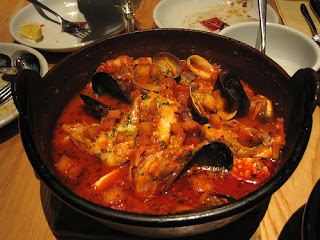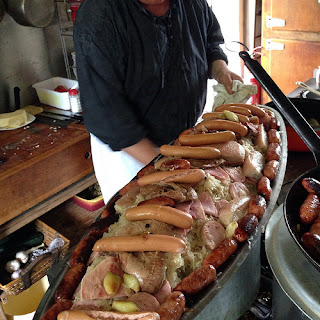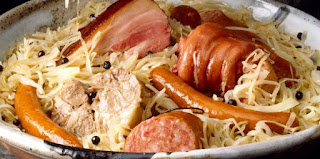A
bouillabaisse.
A
genuine bouillabaisse is a whole meal.
Do
not order an hors d’oeuvre or an entrée if
you are
in a restaurant that serves a real bouillabaisse; it is a very large
meal.
www.flickr.com/photos/birdies-perch/407676260/
The taste of a Bouillabaisse
Bouillabaisse’s unique taste comes from a recipe that includes a special fish stock blended with saffron and garlic combined with fennel, thyme, parsley, olive oil and of course, the fish. It is not often that you have the opportunity to enjoy a dish where saffron really comes to the fore and bouillabaisse is that dish.
Served alongside each diner’s bowl will be a thick rouille sauce, grated Gruyere or Parmesan cheese, along with garlic toast or croutons. The rouille sauce is a made with Provence’s famous aïoli garlicky mayonnaise, to which chilies have been added to make it spicy. Worry not the diner controls the spice.
Rouille,
grated cheese, and slices of toasted
and garlic-flavored baguette.
The Rouille sauce.
Rouille sauce, the word means rust and refers to the sauce's color, is not unique to bouillabaisse; a rouille sauce accompanies many other French fish soups. All rouille sauces will be slightly different; the chef matches the rouille to flavor a particular soup correctly.
Few French recipes are really spicy and for that reason, you, the diner, add the spicy rouille to your preferred taste. Each diner also chooses how much of the grated cheese and toasted baguette or croutons to add. I add the rouille, firstly to the garlic toast, and taste it, then I dip a little in the soup and taste it again. Then I can finally decide how much of the rouille I want to add to the soup.
A serving of
bouillabaisse.
www.flickr.com/photos/birdies-perch/377586026/
The serving of bouillabaisse in two parts
Restaurants who have enough trained staff and enjoy presenting restaurant theatre will serve a bouillabaisse in two parts. The serving of bouillabaisse in two stages, when correctly done, makes a wonderful meal even more enjoyable. First served is the soup, usually with an additional bowl placed in the center of the table; that extra bowl is on hand for second and third helpings. The soup, when the diners have finished, will be followed by the second course, the fishes that were cooked in the soup. A server, often it will be the Maitre D’, will then fillet the fish with a minimum of hand movements; a theatrical show of genuine expertise and excellent restaurant theatre,
The soup
from a bouillabaisse.
Photograph
by courtesy of basykes
www.flickr.com/photos/basykes/3695328099/
Despite the enjoyment of the dramatic when a bouillabaisse is served in stages many truly excellent bouillabaisses are found in smaller restaurants. Restaurants that do not have the staff for separate servings may have a great chef in the kitchen and separate servings were never part of the dish’s origins. For the original fishermen and fisherwomen’s fish stews, there were no waiters around.
The stamp that honors
Bouillabaisse.
Bouillabaisse is part of the French soul; the French issued a
stamp in its honor.
Bouillabaisse on French menus.
Bouillabaisse or Le Vrai Bouillabaisse – The real Bouillabaisse. If the restaurant is a fish restaurant, expect the real thing. When in doubt, ask how the restaurant serves its bouillabaisse.
Bouillabaisse de Pécheur – A fisherman ’s bouillabaisse. You will see this on menus along the tourist routes in the South of France. The small print on many of these menus note that only one to three different fish will be included; all variations come with different prices. The different types of fish affect the price as well as the taste. Just as there is no free lunch, there are no cheap versions of a real bouillabaisse. Look carefully at the menus outside restaurants that seem to offer bouillabaisse; if there is small print read it. These variations are often far from the original and usually much smaller; however, when a whole bouillabaisse is too large a meal, say at lunchtime, consider these offerings as fish soup and enjoy.
The fish
market in the old port of Marseille.
www.flickr.com/photos/julien-carnot/8575426805/
Bouillabaisse du Nord - A sea fish and seafood soup from the North of France. These are often excellent fish soups, but with different fish to those in a Meditteranean bouillabaisse. Despite that caveat I have often found these soups to be delicious fish soups; so I just enjoy them and ignore the word bouillabaisse.
Bouillabaisse Marseillaise – The Mediterranean port city of Marseille claims the original Bouillabaisse Marseillaise recipe from sometime in the 1800s. Many menus in the South of France offer bouillabaisse; however, Marseille owns the trademark. The Charter of the Marseillaise Bouillabaisse was written much much later, in 1980. The charter sets down the rules for an authentic Bouillabaisse Marseillaise, and I have noted the fish and shellfish in the charter in a separate post.
With or without the charter, the tradition of bouillabaisse still varies among chefs who specialize in this dish. Each of these chefs will be true to a tradition, it may be that of his or her mentor, or to a recipe inherited from his or her Grand-mère or Grand-père.
Bouillabaisse Royale – A bouillabaisse served with a half or whole spiny lobster, a langouste, on top; sometimes a crab. The spiny lobster is the owner of the lobster tail. A Bouillabaisse Royale is a dish created to impress the tourists, French as well. Lobster tails make excellent eating, as do French crabs, but after a genuine bouillabaisse who needs one?
The most
popular crab
in France.
What is the most important ingredient in bouillabaisse?
The chefs and Maître D’s in Marseille will tell you that the that the fumet, the fish stock, along with the saffron are the most critical ingredients. Nevertheless, that fumet depends on certain fish as set out in the Charter of the Marseillaise Bouillabaisse.
Some of
these fish will be in your Bouillabaisse
www.flickr.com/photos/banyan_tree/5055394584/
Bouillabaisse a long way from home.
Having enjoyed, in authentic French restaurants that were far from France, a number of excellent bouillabaisses I lean to the fumet, the fish stock, and the saffron being the most critical part of the recipe. The fish stock used is prepared with vegetables, garlic, herbs, spices, white wine, and white wine vinegar and the heads and bones of fish. The fish stock is the real secret behind the perfect bouillabaisse.
The place where bouillabaisse began and the origin of its name.
Bouillabaisse began in the port of Marseille on France’s Mediterranean coast; then it was a meal prepared by fishermen and fisherwomen as they returned home. Provencal, a dialect of Occitan, is the language used by most of the Marseille fisher-folk, and in Provencal Bouillabaisse is Boiabaïsso. The origin of the Provencal/Occitan word is similar to the French; in French bouillir means to boil, and the word abaisser, means to reduce, and voila we have bouillabaisse. Saffron, the most expensive herb in the dish, was always very expensive, but it was, and some saffron still is, locally grown, as are all the other herbs and spices.
The Original Bouillabaisse
As a working fisherman's and fisherwoman’s meal the original Bouillabaisse used the fish that did not sell well; fish and shellfish that were quickly sold were never for the fishermen or fisherwomen or their families. Fish like John Dory or monkfish, as well as shellfish like the spiny lobster, even mussels, would all have been sold. What was left would be members of the very tasty but poison spined sea robin, the scorpionfish family, along with the weever fish, the conger eel and the cigale de mer, the slipper lobster.
Today a Bouillabaisse often includes much more expensive fish along with shellfish and mussels that were never in the original recipe; we can enjoy the additions despite the implied lack of respect for the original recipe. Even the searobin, the scorpionfish, now that it is supplied to fish markets and restaurants without its spines, is no longer an inexpensive fish.
Catching
the ingredients
Bouillabaisse in New York
I enjoyed an East Coast Bouillabaisse in an exclusive Manhattan, NY, USA, restaurant, and that was not a traditional bouillabaisse either; nor did it pretend to be. The two-clawed lobster, shrimp and the fish in the dish I was served would never have been part of any traditional bouillabaisse stew. The soup’s taste, obviously down to a perfect fish stock, along with wonderful fish, was very close to the best that I have tasted in Provence, even the rouille was excellent; altogether it was a wonderful bouillabaisse. Who was I to criticize a really excellent bouillabaisse that had kept its essence; even if it had strayed far from its home port.
You can buy many of
the fish in New York.
www.flickr.com/photos/smoovey/3263779604/
The Charter of the Bouillabaisse Marseillaise.
In the Marseille Office de Tourisme, I obtained a copy of La Charte de la Bouillabaisse Marseillaise, the Charter of the Marseillaise Bouillabaisse. The charter was written in 1980 by a group of three Marseillaise's restaurateurs and was dedicated to preserving the traditional bouillabaisse recipe. The original three have since been joined by many others from France and elsewhere. They may not succeed in ensuring that every chef uses the same fish, but if they preserve the taste that is enough. While the Marseillaise Bouillabaisse charter insists on the use, where possible, of the original fish it does allow for the use of a number of different and more expensive fish and shellfish when the originals are not available.
Park
your yacht in Marseille
www.flickr.com/photos/tango-/32117044816/
--------------------------------
from
Behind the French Menu
by
Bryan G. Newman
behindthefrenchmenu@gmail.com
Copyright 2010, 2014, 2019.
--------------------------------
Searching for the meaning of words, names or phrases
on
French menus?
Just add the word, words, or phrase that
you are searching for to the words "Behind the French Menu" (best
when including the inverted commas), and search with Google, Bing, or another
browser. Behind the French Menu’s links, include hundreds of words,
names, and phrases that are seen on French menus. There are over 450 articles
that include over 4,000 French dishes with English translations and
explanations.
Connected Posts:


















